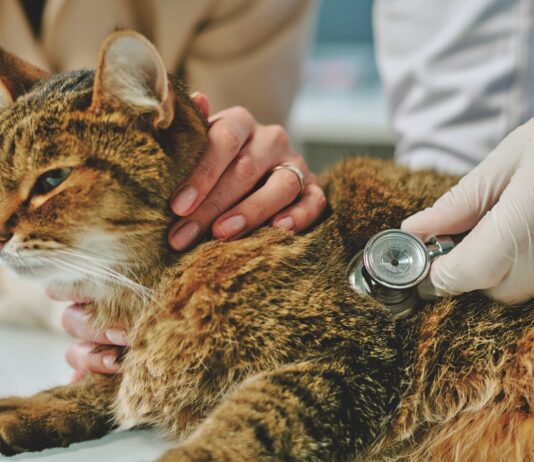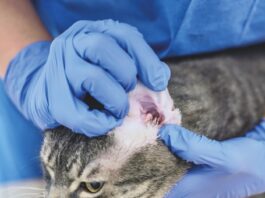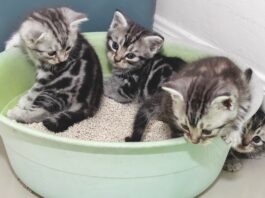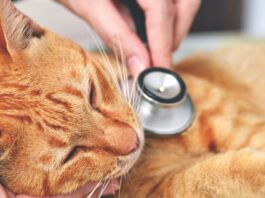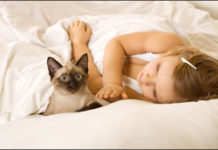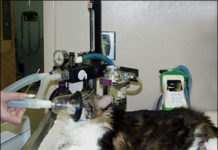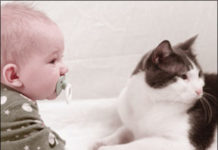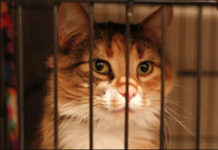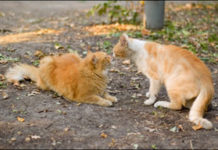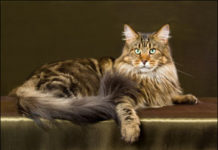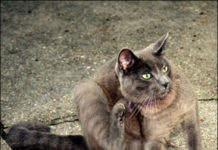Feline Upper Respiratory Infections
Your seven-year-old cat is a generally healthy animal. Except for a fleeting bout of gastrointestinal upset a few years ago, shes never had a really serious sick-day in her life. But your neighbors cat always seems to be ill. Every couple of months, she shows up on your doorstep wheezing and sneezing. Her eyes are red and watery, and she acts lethargic. These disturbing signs persist for a week or so, but then she seems to be okay again for a while. Its quite likely that the cat next door is suffering from an upper respiratory infection, a highly contagious disease affecting her nose, sinuses, pharynx and larynx the structures that filter, heat and dehumidify inhaled air before it flows to her lungs. Why is it, you wonder, that your cat never experiences this problem, while the cat next door cant shake it?
Indoor Allergies and Your Cat
Though outdoor allergens (substances that can cause the immune system to respond with an allergic reaction), such as pollen, are considered to be the main culprits in causing allergies, indoor allergens, such as the common house dust mite, actually have the potential to be much more reactive. As humans, we generally have the most difficult time with indoor allergens when they are airborne and are inhaled into our upper respiratory tract. Though we consider our feline pets to be members of the family, most cats do not respond to airborne particles with an allergic reaction in the respiratory tract - unless the cat is asthmatic, notes William H. Miller, VMD, professor of medicine, chief of the section of dermatology, and medical director of Cornells Companion Animal Hospital.
Chronic Respiratory Disease in Cats
Chronic rhinosinusitis (CRS) is a common disease in cats with an unclear cause. A number of studies have indicated that most cases of upper respiratory disease in the cat are complicated by secondary bacterial infections. Antibiotic therapy is frequently employed to treat feline CRS. A study published in the Journal of Feline Medicine & Surgery evaluated the effect of sampling method on culture results in 44 cats.
Critical Care for Your Cat
A virtually comatose cat was rushed by its distraught owners into the emergency unit of the Cornell University Hospital for Animals (CUHA). The animal, a neutered two-year-old male, hadnt eaten a bite of food or consumed a drop of water for the previous 24 hours. The night prior to his arrival at the hospital, the cat had spent nearly an hour straining in his litter box, apparently in considerable pain, but had neither urinated nor defecated. When his owners awoke the following morning to find the poor animal vomiting intermittently, they finally agreed that emergency care might be warranted. Lucky for them, not to mention the ailing cat, they moved into action. By the time they reached the hospital, the cat was breathing with great effort and lying motionless on his side. A team of veterinarians and licensed veterinary technicians immediately noticed that the animals bladder was grossly swollen. Clearly, it had a blockage in its lower urinary tract that prevented the passage of urine. The team went speedily to work, feeding fluids into the animal intravenously while relieving the obstruction in its urethra.
Anesthesia: Whats Involved?
Any surgical procedure that will be painful to your cat - whether its a matter of stitching up a wound, pulling a tooth, repairing a fractured limb or removing a diseased organ - will require that the animals pain perception be dulled, if not totally blocked, by an anesthetic of some sort. What are the chances, an owner might wonder, that the animal, while surviving the operation itself, will fail to fully regain its senses? Or worse: What if it fails to awaken from its drug-induced sleep? "Theres always a risk," acknowledges James Flanders, DVM, an associate professor of surgery at Cornell Universitys College of Veterinary Medicine. "But if the cat is known to be in generally good health and if the anesthetic drugs are used properly, the chance that something will go wrong is very slim." Dr. Flanders assessment is supported by a study published in the Journal of the American Animal Hospital Association that involved tens of thousands of cats. Results showed that for every 1,000 deaths occurring during or subsequent to feline surgery, only one could be directly attributed to anesthesia. This impressive safety record is largely attributable to gains during the past half-century in understanding the medications that are used, and the techniques for monitoring the condition of the animal.
When Your Cat Wont Eat
When a cats food intake drops off, for whatever reason, the resulting decrease in protein intake can trigger feline hepatic lipidosis (FHL), which is the most common form of liver disease in cats. Inadequate protein mobilizes fat from the adipose tissue, and the fat then accumulates in the liver. "Its a vicious cycle," says Ned Kuehn, DVM, MS, a veterinary internist with Michigan Veterinary Specialists in Southfield, Michigan. "When a cat decreases her food intake, more fat accumulates, making the cat feel worse and eat even less. This makes the hepatic lipidosis get worse." The cat becomes anorexic, and severe liver failure occurs - often in as little as a couple of weeks. "Ive seen it happen within a week," says Dr. Kuehn.Some of the Causes. A wide range of conditions can trigger FHL. "About forty percent of cases are due to environmental changes in the house," explains Dr. Kuehn, who is board-certified by the American College of Veterinary Internal Medicine. Triggers include vacations, moving, a new baby, workers in the home, divorce and even teenagers leaving for college. "Cats become stressed and decrease their food intake," says Dr. Kuehn. Illnesses such as diabetes mellitus, hyperthyroidism or cancer; traumatic injury; or the presence of a foreign body in the intestinal tract may also lead to FHL.
Microchips to the Rescue
A study published in the Journal of American Veterinary Medical Association ("Characterization of animals with microchips entering animal shelters," July 2009) determined that 7,704 microchipped animals entered 53 animal shelters between August 2007 and March 2008. Of this number, strays made up more than half (53 percent), with the remainder considered as owner-relinquished animals (41.9 percent) and other (5.1 percent). The results showed that animal shelters were able to find the owners of three-fourths of stray dogs and cats with microchips. The sucess in finding owners was higher in dogs, animals that were purebred and animals that were spayed or neutered. Animal shelters had a much higher likelihood of finding an owner when the owner information was in the shelters own database or registered with a microchip registry. The results emphasize the importance of the registration process in successfully reuniting pets and owners.
Abscesses: Take Them Seriously
For several days, your cat has been acting uncharacteristically lethargic and off his food. Then one evening, while stroking his back, you feel a smallish lump just to the side of his tail. Although you touch the lump gently, he responds with a hiss, leaping from your lap and scurrying into a dark corner. The lump you discovered is quite possibly an abscess, and the sensitive swelling may indicate that the cat has an infection - and necessitating prompt veterinary care. Distinctive Characteristics. An abscess is a localized collection of pus, a yellowish fluid that forms at the site of an infection. Although pus typically contains a certain amount of cellular debris and dead tissue, it is composed mainly of white blood cells that have been summoned by the immune system to combat invading bacteria or other microorganisms. Cats can develop a variety of lumps and bumps on their skin - cysts, tumors, pimples and so forth - but abscesses have their own distinctive characteristics, notes William Miller, VMD, medical director at Cornell Universitys Companion Animal Hospital. "Because an abscess is filled with pus," he says, "it will be inflamed, warm and tender. Tumors are not usually like that, and pimples are merely superficial eruptions, affecting the outer layer of skin and minuscule by comparison to an abscess." External and Internal. An abscess may develop at the site of a penetrating wound - if a cat steps on a thorn, a wood sliver or a piece of glass, for example. But abscess-producing infections in cats usually result from bites from other cats, since the bacteria that cause infection are normal inhabitants of the feline mouth.
Keep a Feline Health Diary
If your cat kept a diary, it might read something like this: Yesterday, I slept, ate, slept some more, chased a paper ball, napped, ate again and napped. While that may describe a cats typical day, it wont necessarily help you or your veterinarian if your cat develops a health or behavior problem. "Keeping a diary for your cat is a good idea in general, but particularly when your cat is ill," says Drew Weigner, DVM, who is board-certified by the American Board of Veterinary Practitioners. Keep Track of the Basics. At a minimum, you should track your cats veterinary visits, vaccinations, flea treatments and any medications your cat takes. Beyond that, record anything that is unusual for your particular pet. For example, if you change your cats diet, note the date and track changes (such as vomiting or diarrhea). Or, if your cat urinates more or less often than usual, record that in the diary. "If there is anything unusual, or if you start seeing something more often, you should take a trip to the veterinarian," says Dr. Weigner, whose practice is The Cat Doctor in Atlanta, Georgia. If your cat exhibits any changes in behavior, you should note anything unusual thats happened in the house, such as human visitors or changes in the environment. Are strange cats hanging around outside? "Anything can act as a trigger," says Dr. Weigner. "Keeping a journal helps separate the subjective from whats objective. If you keep a log of it, you know for sure."
Diagnosis: Heart Disease
Although one cat may be prettier, smarter or more athletic than another, nature plays no favorites when it comes to doling out heart disease. All cats are at potential risk for serious insult to this vital organ. In some cases, the signs are obvious to the trained eye. In others, a serious heart disorder can remain hidden for years before finally expressing itself in a sudden, perhaps fatal, deterioration of function. The best thing that owners can do is to make sure their cats have thorough medical checkups - at least once a year - during which the veterinarian pays close attention to the heart. While examination with a stethoscope cannot detect all feline heart diseases, its probably the most cost-effective approach to diagnosis in otherwise healthy cats. Congenital Defects. Most feline heart disorders are acquired during the course of an animals life, but others are present at birth. However, says John Bonagura, DVM, a professor of veterinary clinical sciences at the Ohio State University Veterinary Hospital, congenital feline cardiac disease is relatively rare, occurring only in an estimated one or two percent of kittens. The most common congenital disorders, he notes, are heart valve malformations and holes in the septa. Abnormal valve development most often involves the mitral valve, located between the left atrium and the left ventricle. While a number of structural problems can occur, the end result is typically a valve that cannot close properly and thus allows blood to leak backwards into the atrium. Holes in the septa most frequently affect the membrane partitioning the right and left ventricles and may also cause the inappropriate flow of blood between the heart chambers.
The Challenge of Skin Disorders
One of your favorite things about your cat is her sleek, shining fur. Lately, though, it seems like your cat has been having a bad fur day. Nothing can be more frustrating and annoying than skin disorders. Nutritional deficiencies or food hypersensitivity; parasites; fungal, viral and bacterial infections; and environmental allergens can cause problems that range from dry, brittle hair and coat to baldness and open wounds. "Most skin diseases are simple and straightforward," says William Miller, Jr., VMD, professor of dermatology at Cornell Universitys College of Veterinary Medicine, "and common problems such as flea bite allergies, abscesses (see related article in this issue) and ear mites are easily recognized, treated and resolved." If a cat can absorb the nutrients in food and is being fed a nutritionally complete diet, food is probably not the cause of the skin problem. If a cat has abnormal absorption or a gastrointestinal disease, or is being fed nutritionally inadequate home-cooked food or unbalanced "people" food, the problem may show up either as vomiting or diarrhea or as skin disease. "We dont usually see both," says Dr. Miller. The more esoteric causes of skin disorders are allergies, and they may require some investigative work to uncover. "From a dermatologic point of view, we see allergic reactions more often than other skin problems," says Dr. Miller. "And you cant always tell if the allergy is to food, drugs, pollen or other sources."
Short Takes: 10/09
House Resolution 3501 - more commonly referred to as the Humanity and Pets Partnered Through the Years, or HAPPY Act - would amend the Internal Revenue Code to allow an individual to deduct up to $3,500 for "qualified pet care expenses."These expenses are defined as "amounts paid in connection with providing care (including veterinary care) for a qualified pet other than any expense in connection with the acquisition of the qualified pet." "Qualified pet" is defined as "a legally owned, domesticated, live animal." It does not include animals used for research or owned or used in conjunction with a trade or business. Introduced on July 31, the measure was drafted in conjunction with data from the American Pet Products Associations National Pet Owners Survey. It has been referred to the House Committee on Ways and Means. The Pet Industry Joint Advisory Council (PIJAC) issued a Pet Alert on Aug. 5 supporting the proposal. "Providing pet owners the opportunity to deduct pet care expenses is an important step towards ensuring that pet owners provide adequate veterinary and other necessary pet care," PIJAC stated. "It encourages responsible pet ownership and will hopefully reduce the abandonment of pets by people struggling as a result of the economic downturn."

